During the late years of WWII, the US military worked diligently on a replacement for the M1 Garand rifle, which was designated the T20. This was basically an M1, with the addition of a trigger group allowing full automatic fire and with a 20-round box magazine in place of the M1’s 8-round clips. As long as the war continued, this project was pursued with some sense of urgency, and rifles were being actively tested in 1945 and late 1944. By May of 1945, the Ordnance Technical Committee actually recommended procurement of 100,000 T20E2 rifles – a sure step towards their general adoption. However, the war ended a few months later, and the project was no longer particularly time-sensitive. The large order of T20s was not formally placed, and the immediate plans to replace/update the M1 rifles in service were all shelved. Instead, it was decided to pursue a new lightweight rifle program based on the developmental T65 cartridge (which was to become the .308 Winchester and 7.62 NATO). The Olin Corporation had developed a new type of ball powder which would allow the Army to duplicate the performance of the .30-06 cartridge with a half-inch shorter case. This was seen as a valuable way to reduce rifle size and cost.
The head of US small arms R&D, Colonel Rene Studler, anticipated this change of focus, and in March of 1945 he assigned a 37-year-old designer named Earle Harvey to study the characteristics of military breech locking systems and develop an ideal light rifle. Harvey had been toying with designs in his own time since 1942, and he dove right into the project. By the end of 1945 Harvey had a completed design for what would be known as the T25:
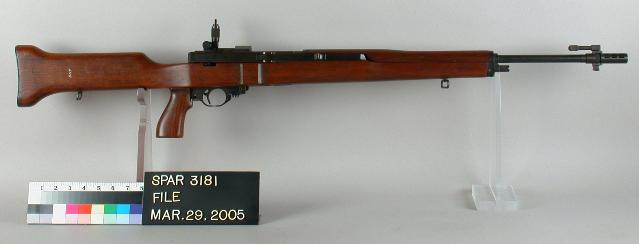
Harvey was a skilled designer, and his previous work included a new gas system for the M1, which was made as the experimental M1E9, and would eventually be used in the M14 rifle. He used that gas system in the T25, along with a tilting bolt mechanism which locked into the top of the receiver (somewhat like a Bren LMG). Since the force of firing would push this type of bolt directly back against the locking shoulder in the receiver is would put the bolt in compression. A rotating bolt like the M1 used, by comparison, puts a large shear force on the bolt’s locking lugs, which requires tougher steel and more machining to construct. Harvey judged that his tilting bolt would be both stronger and cheaper than the M1 bolt – and was right, too. In a firing test on May 18, 1948 the T25 was found to withstand chamber pressures of 125,000 psi without and increase in headspace, and pressures of 150,000psi without and parts breakage.
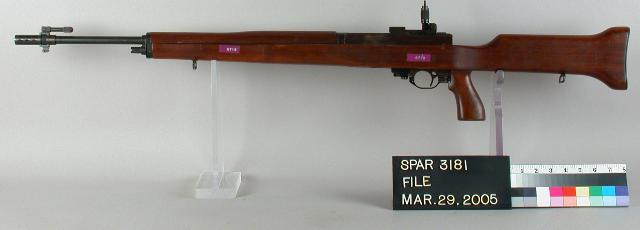
Harvey also considered several other important factors in his design, including simplicity of manufacture. Given the new nuclear dimension of warfare, the component parts of the T25 were designed to be fabricated with generalized tooling and machines as much as possible, so that production could be distributed to numerous small shops in case of a nuclear strike on the US. Harvey was also very conscious of weight in the rifle, and made use of aluminum and deliberately lightened designs for parts not under direct stress (like the buttplate and trigger guard). The result was a full-power rifle (it was chambered for the 7.62mm T65 cartridge) weighing a mere 7 pounds (unloaded) – a significant technical accomplishment. To mitigate the recoil from such a light overall weight, the design utilized an in-line stock and muzzle brake.
The first four prototype T25 rifles were made under contract for Springfield Armory by the Bennel Machine Company out of Brooklyn, and first completed rifle was test fired in January 1948. A more formal endurance test in April 1948 saw 3500 rounds put through gun #3, with no parts breakages or weakened components. By August, Col. Studler was contracting with Remington for more prototypes to be made (12 were delivered in December 1949, having been delayed several months by design changes). Another 110 were ordered in the summer of 1949, although this quantity was shortly revised to just 50. Production of these early guns was repeatedly delayed by changes requested by the Springfield Production Engineering Branch, as being necessary to make the rifle practical for mass production.
In actual fact, the T25 was no more complex to manufacture than the M1, and the delays to prototype production were founded in an administrative bias at the Armory again new development, rather than actual shortcomings of the T25 design. The final lot of rifles made be Springfield Armory was finally delivered in the summer of 1951. This bias against the rifle would come back to haunt the T25 as one of the main reasons behind its cancellation…
Army testing of the T25 began in September 1948 at Aberdeen Proving Grounds, and the results were quite good. In the first test, the T25 was found to be more accurate than the M1 rifles used as a baseline, and to operate well under adverse conditions, considering its current level of development. Problems were reported with firing pin breakage and erratic ejection patterns, but nothing was particularly surprising or could not be fixed with some more work. In 1949, the decision was made to also restart development of a lightened M1 rifle, and for the following three years (1949-1951) that project would run parallel with the T25.
The next Aberdeen trials were in February, May, and June of 1950, with the T25 competing against the FAL and EM2 rifles (both in .280 caliber). The T25 showed some weakness in some adverse condition tests, but outperformed its European rival in others. It did have problems caused by poor-quality ammunition, as the batch of T65 ammo supplied for the testing gave erratic pressures. It also had problems with some improperly parkerized parts, and performance improved in the last parts of the testing after these parts had been replaced. Overall, the T25 was a fundamentally sound rifle in need of more development work. Earle Harvey was the only engineer assigned to the T25 project, and he had significant other duties as well. The quality of the rifle is particularly impressive considering the limited time and money that was allocated to it, and it reflacts very well on Harvey’s skills as a designer.
Ultimately, internal administrative bias towards the existing M1 rifle led Col Studler to decide to drop the T25 program late in 1951 or early in 1952, although this decision still had to be made to look like a fair and objective choice. Another round of testing was scheduled for 1952, to include the T25, T44 (Springfield’s product-improved M1, which would eventually become the M14), the Belgian FAL, and the British EM2. Harvey was unable to get the time and engineering assistance necessary to iron out the issues with the T25, as intended by Ordnance Department higher-ups, and the result of the testing was the T25 (and EM2, for what it’s worth) being formally dropped from consideration.
For all the work and political maneuvering of the T25 and T44 (and the other shorter-lived experimental rifles of the period, including the roller-locked T28 and John Garand’s bullpup T31), the program was ultimately doomed to failure. The entire premise of the light rifle program since its inception in the autumn of 1945 was to devise a single standard rifle which could serve as light machine gun, rifle, carbine, submachine gun, and sniper rifle. It became clear to Harvey and the other designers, as it should have been clear to everyone, that the requirements were contradictory and impossible to fulfill. A 7-pound weapon using a full-power cartridge could never be an effectively controllable LMG, and the same gun would yet be too large and heavy to be an effective replacement for the M1 Carbine. The T25 was repeatedly found to be too light to be controllable in full auto, but the design requirement was never altered. This giant elephant in the room of the light rifle program was studiously ignored clear through the adoption and mass production of the M14 rifle, and only really addressed with its replacement by the M16.

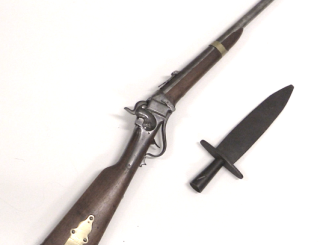
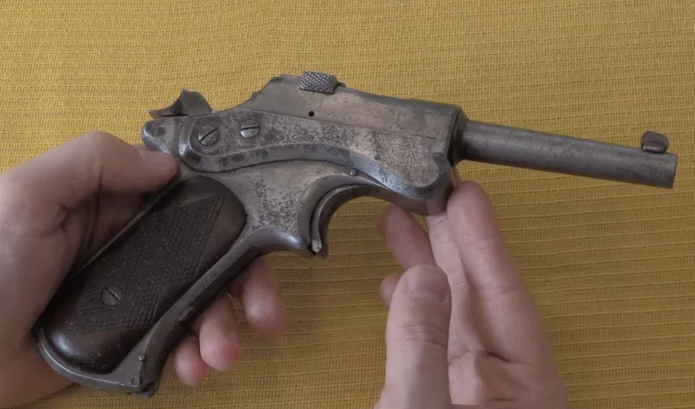
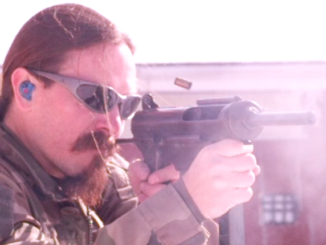
wow slow learners, those DOD people. This reads exactly like the XM8 story.
Eric, managers (DOD or not) are not slow learners. They have no need to learn, because they already know everything. I am convinced that no manager involved in the XM8 program had the slightest idea about the T25.
looks as if they had seen a fg42 and wanted to mimic its excellent attributes
They even copied the FG42 folding front and rear sight. Notice the rotating drum aperture. It seems almost farcical.
No, it’s a copy of the Johnson M1941/M1944 LMG elevating aperture [& predates the FG42’s version thereof], which Harvey almost certainly had some awareness of/experience with, given the closeness of the American firearms industry during the war.
Actually kinda surprised there’s no entries for the Johnson rifles here on FW.com, given that Johnson’s efforts, despite his purely civilian financed & led status, were the only other firearms that came close to rivaling the BAR’s & M1 Garand’s performance in WWII. In fact, the Johnson LMG was arguably *better* than the BAR, & if it wasn’t for the Ordnance dept.’s NIH attitude, might have had the functioning double-stack magazine it so desperately needed: if it wasn’t for their efforts to sabotage the test of the m1941 LMG for acceptance as a substitute standard, Johnson might have kept up his efforts to adapt the BAR mag to work with it…
Yeah, I definitely need to add some material on the Johnson rifle and LMGs – just haven’t gotten to them yet (and at the moment, I don’t have access to any for shooting).
Yet another prominent example of the internal machinations and closed-minded prejudices often prevalent in selection committees that effectively prevented the adoption of a potentially superior battle rifle. Also quite possibly an indictment against the top brass who were responsible for appointing those selection committees.
What a pity — the T25, in fully-developed production form, might have proven a worthy rival to the FN FAL.
That prototype buttstock bears a certain resemblance to the FG42’s. The raised upper edge looks as if it would have provided a very comfortable cheek weld, much like a Monte Carlo stock. Did the large size of the stock provide additional internal storage for a cleaning kit, spare parts, etc.?
“It became clear … as it should have been clear to everyone, that the requirements were contradictory and impossible to fulfill”
This is a problem that plagues US military firearms development and purchasing to this day. They set unrealistic goals for a new firearm, fail to meet them, and then lose their justification for the replacement project and so get stuck with the old one for another 10 years. Rinse, and repeat. They have gone through this cycle multiple times now.
Firearms are a very mature technology. Improvements are incremental, and these days are likely to be mainly in marginal improvements materials. The reality is that you can’t have everything. You have to set priorities on what you think is most important and be satisfied without the less important things. If they were willing to do that, they could get something that is a lot better *under field conditions* than what they have now. If you demand everything however, you get nothing.
This mentality is not something that is confined to firearms. The “contradictory and impossible to fulfill” requirements fiasco is being played out on a far larger scale with the F35 fighter. Projects like that though are “too big to fail” regardless of how poorly they turn out.
You brought up a very salient point. The “one size fits all (and do everything)” concept in aviation has been around for a long, long time. Remember the TFX project from the late 1950’s-1960’s that eventually gave rise to the venerable F-111 variable-geometry fighter-bomber? The multi-role concept was a huge failure because planners tried to achieve too much with a common airframe design to satisfy all the diverse needs of the Air Force and Navy (two very different users with different needs), and it was only when the strengths and limitations of that design were properly recognized and focused upon that General Dynamics was finally able to produce a capable aircraft that successfully filled a more limited niche, i.e., as a strike and interdiction bomber or fighter-bomber that entirely abandoned the fighter and interceptor roles, and even then only to fulfill the requirements of one entity, the USAF.
The history of aviation has seen some very effective multi-role combat aircraft entering active service, but only when strict and realistic parameters have been set and adhered to regarding their recognized limitations in those roles. The result has been aircraft that are reasonably good at multiple tasks, but which excel in perhaps only one or two specialized areas. A prime modern example is the Panavia Tornado, which is outstanding at high-speed, very low-level terrain-following tactical strikes, and which performs adequately as an interceptor and in air combat. Going further back, the DeHavilland Mosquito of World War Two was another well-known example, as were the DH-4 and DH-9 of the First World War.
It is when one over-reaches and tries to build an aircraft ( or any other weapon system, for that matter ) that is supposed to be outstanding in every single aspect of total performance to satisfy every end-user’s requirements to the highest degree that one runs into really serious technical and financial difficulties, as in the case of the F-35 Joint Strike Fighter.
Absolutely true, Earl! The aviation examples you mentioned provide an even better view on what is at stake when companies and/or staff planners go after the mythical “one size fits all (and do everything)” chimera… Cases of aircraft that could perform (reasonably enough) a wide variety of roles can be produced quite easily, but I also fully agree with you on the basic fact that such machines usually only excel in one or at best two specific fields; to your list, I’d like to add a few more twin engined multi-role aircraft designed in the late 30s (or already during WW II), like the Junkers Ju 88, the Soviet Petlyakov Pe-2, the Bristol Beaufighter or the unsung but significant Lockheed PV-1 Ventura, which despite being derived from a transport type, was conceived as a bomber for a RAF requirement(at first, the Brits used theirs for highly dangerous, almost suicidal open daylight raids deep in German occupied Europe, soon proved to be a very, very bad idea).
When the PV-1 started to be used by the USN (the USAAF had a brief but unsuccessful flirt with the aircraft, as the B-37) after December 1942, the type soon blossomed as a top performer in the bombing patrol and attack roles, operating across the vast expanse of the Pacific against virtually everything that moved, from light shipping to submarines, vehicles and aircraft at air bases, etc. A few were used in the night fighting role and equipped with radar, shooting down many different types of Japanese aircraft (including single-engined fighters!). I think the Ventura is a pretty nice example of a good compromise between heavy armament, excellent performance and dependable ruggedness. Such qualities, interestingly enough, were proven in roles never originally envisioned by its designers (and their first client, the RAF, I should add…).
On the other hand, when the original intentions revolve around over-specialization, failure can be even faster and nastier. The sole – relative, as always – exceptions, again in WW II era aeronautics, are the specialized ground-attack types produced and fielded by the Soviets – Il-2 and Il-10 plus a few other, minor types – and, albeit to a lesser degree, by the Germans too – the Hs 129 tank buster springs to mind, although the Ju 87 was also more or less successfully adapted to the role, and a few aircraft designed from the outset as night fighters (the only ones I can remember being the P-61 Black Widow and the He 219 Uhu). A good example of failure when over-specialization is aimed at is the extraordinary (and over engineered, over sophisticated and exceedingly expensive for the budget available to the USAAC in the late 30s…) YFM-1 Airacuda, a twin engined bomber destroyer built by a newborn company (Bell) as their first venture, armed with 37mm cannons on the engine nacelles (the aircraft was designed with a pusher configuration, another very uncommon feature back then) and fitted with a complex fire control system that basically locked the target, as the pilot aimed the aircraft as one would do with a rifle, using a special periscopic-type sight that could be retracted under the aircraft’s nose. In theory, both 37mm cannons would then automatically be set up (the main role of the gunners who seat behind the 37mm breeches under a glazed canopy was to serve as loaders, but in an emergency they could also fire the guns manually). I won’t even mention the incredibly unreliable electrical systems… The whole thing screamed “Why Make Simple When You Can Make Complicated!”
I have to say that I am in complete agreement with you on this. The list of additional examples you have cited from the aviation field is but a relatively small percentage of the total covering similar applications — the list could go on and on if the entire spectrum were to be discussed in any detail. In the end , all point towards the old dictum that “best is often the enemy of good” in real-world applications.
The F4 Phantom was a great all around plane for it’s time. Once they reinstalled the cannon back in them they did give the MIG 21’s a run for their money.
Dean
Yes, the F-4 Phantom is another classical example of a very good all-round performer and multi-role combat aircraft, and it was highly successful for the precise reason that it was fortunately recognized as such, along with its limitations, from the very beginning by McDonnell-Douglas and the USAF and USN / USMC evaluation teams charged with appraising it for eventual introducion into service. It is to their credit that the Phantom ended up being used correctly in multiple roles that did not exceed its known capabilities. Add to this the fact that it was highly adaptable, and the aircraft continued to be able to fulfill and extend its niche in those roles, often for a much longer time than originally envisaged. A case in point is the introduction of the M-61A1 20mm Vulcan rotary cannon in the form of a self-contained external gun pod that could be fitted to the F-4B, C and D models for dogfighting with North Vietnamese MiG’s, and eventual integration of the same gun in the form of a permanent installation in the lower centerline just behind the nose in the F-4E. Prior to the F-4E, all earlier versions had no gun armament at all (until the advent of the gun pods), and were wholly dependent on missiles, along with their obvious drawbacks in close-in air combat.
The Phantom did a lot of things very well, but was not absolutely outstanding in any single area of performance versus its more specialized rivals when they are considered as a group ; it also outperformed them on an overall basis for precisely the same reason. If the same sort of demands had been placed upon its design as happened with the TFX programme — where it would have had to be the ultimate answer in every conceivable role as required by hugely differing demands emanating from multiple users — it might have failed to deliver. Fortunately, a much more realistic approach was adopted with the F-4’s designated roles.
The scuttling of the T25 program comes as no surprise: The natter of government is retardation. My experience is that all of man’s accomplishments are in spite of government, not because of it! For example, the only “improvement” governments can offer Re the Internet is restriction. The reason commonly given for not fielding a 7.62NATO class automatic rifle is that it is uncontrollable in said mode. What they don’t say is that the problem can be solved by using an effective muzzle brake like a JP recoil eliminator. I am aware of the muzzle flash & blast caused by effective muzzle brakes, but it is a small price, I think, for a controllable gun. I am not saying muzzle brakes are applicable to every situation. PS: I would love to have a look inside the T25
From what I’ve read in various places, Springfield Armory seems to have been something of a hotbed of bitchiness and politicking.
Where a manufacturer which is either privately owned or owned by a small state, needed to come up with designs that appealed to many customers, Springfield appears to have wanted to dictate what its customers should like.
In the run up to WW1, when Fred Colvin and Machinery Magazine got the job of cataloging and explaining the manufacture and guaging of the ’03 rifle, so private contractors could compile bids for manufacture,
Colvin, suggested some improvements which the armory could make to its techniques – that was Colvin and Machinery Magazine’s role in the private sector -spreading information on best practice.
It is said that those in the armory were highly offended and took his suggestions as belittling insults.
Somewhere, I have a .pdf of a “history of Springfield armory” by “Rabe associates”
I’ve tried a search but can’t find a link for downloading them.
Link to the .pdf history of Springfield Armoury
http://www.nps.gov/history/history/online_books/spar/spfld_armory_history.pdf
Highly pedantic correction, if US2714334 is the T25 breech mechanism patent, and I think it is, the T25 did not have a tilting bolt mechanism. There’s a locking flap on top of the bolt that rises into the locking recess, which incidentally is also the ejection port!
http://ww2.rediscov.com/spring/full/3181-JPG633536160314469392.jpg
Think of it as the bastard lovechild of a Glock and a BAR.
Earle Harvey’s patents
http://www.freepatentsonline.com/2380965.pdf
http://www.freepatentsonline.com/2397963.pdf
magazine patent
http://www.freepatentsonline.com/2434269.pdf
Excellent additional information that helps add substance to the story — I certainly learned a lot. Thanks, Mark!
Earle Harvey was my wife’s uncle. I had many conversations about the T25 rifle after his retirement. He told me the whole story of really what happened. Politics was a major factor in the rifle’s demise as well as the reluctance of the production engineers and management at the Springfield Armory. The lack of proven ammunition for the testing was also a factor. The program was planned to fail by the people in charge. Oh what a history lesson I received from this gentleman. He was not only a brilliant engineer/designer but also one of the most decent and honest persons that I had ever met. I will never forget the Winchester model 94 carbine that he sent to me for a Christmas present in 1961 as he knew I couldn’t afford to buy a hunting rifle myself. I still have it and it will be passed on to my son to be used.
Richard, it’s incredible that someone so close to the core of the T25 story is right here with us on FW! Thanks for your invaluable personal input — would it be too much to ask, for the sake of historical truth and for the sake of Earle Harvey’s legacy, that you enlighten us a bit more on the details of the T25 programme as you know it?
Thanks very much in advance for coming forward and sharing this.
Minor nitpick: The T65 family was not designed for ball propellants, it was just designed to be reduced-length (all the early test documents I’ve seen use conventional powder). The use of ball propellant came later.